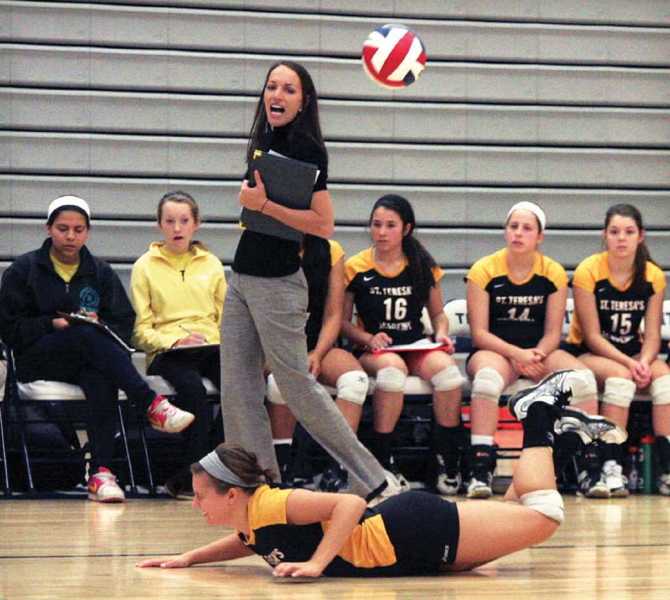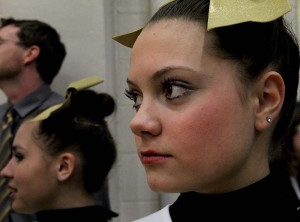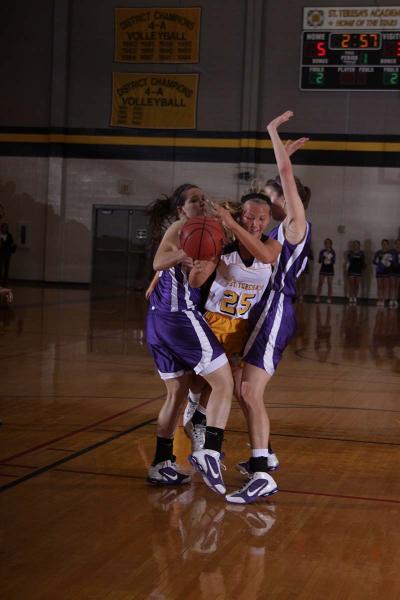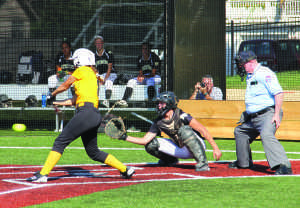story by Lane Maguire and Sara Meurer, photos compiled by Menley Brennan
In the 2010 Sectional match, the STA volleyball team lost to Lee’s Summit West, ending the season with a 24-10 record. After beating Park Hill South in the first game of the 2011 Sectionals, the Stars lost to Lee’s Summit West again in the second game, ending their season. Last November, Lee’s Summit West defeated the Stars for the third consecutive year in the Sectional championship game, ending their season again.
Three straight years. Three straight losses. Same 5A school.
“It’s hard because [Lee’s Summit West has] an extremely strong program and they’re such a strong school,” varsity volleyball player Elaine Schmidt said. “It’s really frustrating when you look at their school and you’re like, ‘Wow, they have so many more people.’ They definitely have an advantage because they can draw so many more players.”

Schmidt is describing the competition that the STA volleyball athletes–and many other STA teams–face as a part of Missouri’s largest and, therefore, most competitive class.
The school’s placement in the largest class in every sport besides dance is the result of a Missouri State High School Activities Association, or MSHSAA, rule. Beginning in the 2002-2003 school year MSHSAA implemented a “multiplier effect” to all private schools in the state of Missouri. The multiplier is an effort to even the playing field for high school athletics.
STA athletes and the athletic department see the multiplier rule as unfair because they say it assumes — incorrectly — that private schools have an advantage through recruitment opportunities and a less restrictive budgetary process. Many of the schools that STA competes against in state competition have many more students than STA–even after the multiplier effect is applied.
The rule often increases the quality of the teams STA plays, however some STA sports teams have thrived since the multiplier, simply because of the talent of that team. Other teams have suffered because of the rule.
However, statistics have shown that the multiplier has actually done little to reduce the number of State championships won overall by STA and other private schools in Missouri — its original intent.
According to an article titled “Prep Plus: Evaluating the Motivations for and Effects of Enrollment Multipliers and Other Measures in High School Sports” by Timothy Epstein, the Chair of SmithAmundsen’s Sports Law Practice Group (Chicago, IL), the Missouri multiplier system “has simply not achieved the desired result of reducing the percentage of State championships won by private schools.” In the ten years before the multiplier was implemented, private schools, constituting 20 percent of Missouri’s schools, won 33.2 percent of all State championships. Three years after the multiplier was implemented, private schools won 32.3 percent of the state’s championships.
The facts
The rule takes STA’s enrollment and multiplies it by two, to account for being a single-sex school, and multiplies that number by 1.35 to account for being a private institution. According to MSHSAA communications director Jason West, “there were multiple studies done and equations to come up with that number.”
This number takes STA’s enrollment from 575 students to 1,552. The multiplier determines which class or division sports teams are placed in, and therefore determines which teams compete against each other. MSHSAA schools are classified every two years based on updated school enrollment figures.
MSHSAA implemented this rule after a vote from its member schools 11 years ago because some high schools were seen to have an advantage over others.
West believes that the multiplier has ultimately been successful in evening the playing field, however significant the changes have been.
“I think in some sports you don’t see [the effects of the multiplier], or it may not have as big of an impact as it does in football or basketball, but I think it has gotten some more parity especially at the smaller school level where you have small schools against larger schools,” West said.
According to a 2003 article in The Kansas City Star titled “Multiplier rule wasn’t a plus for public schools,” without the multiplier during the 2001-02 school year, 36.4 percent of Missouri team championships went to private schools. With the multiplier during the 2002-2003 school year, private schools won 35.8 percent of State titles (with two State champions that had yet to be determined).
History teacher Mike Egner is the former STA athletic director. Egner said the main rationale behind the rule was that public schools believed private schools had an unfair advantage because private schools could recruit students from across public school district lines. As STA’s assistant athletic director from 1998-2000 and head athletic director from 2000-10, Egner attended Missouri athletic directors’ meetings at the time the multiplier rule was being discussed.
“[Public schools] said, ‘It’s not fair so [private schools] should have to compete at a higher level because they can draw students from all over,’” Egner said.
Believing there to be a disproportionate number of State championships won by private schools, many state athletics associations, including Missouri’s, have implemented strategies hoping to reduce the number of state championships won by private schools. According to current STA athletic director Mark Hough, STA is classified in the highest, or most competitive, class in every sport besides dance. This means that STA, considered a medium-sized school by Hough, must compete against the largest public schools in Missouri as part of MSHSAA’s attempt to even the playing field.
“I think there’s an assumption that because you’re a private school, you have a bigger budget, whereas many public schools have experienced budget cuts over the years,” Hough said. “I’ve been at two private schools over the last 15 years and that’s not the case, and it might be the opposite way. We’re trying not to pass costs onto the families, so we don’t just get to go out and buy whatever we want.”
Both Egner and Hough believe that Rockhurst High School’s number of State championships was a large factor in the passage of the multiplier effect in Missouri.
“The multiplier rule everybody voted for because of Rockhurst football, but they didn’t think that they’d just shoved St. Teresa’s volleyball up in the big class,” Hough said.

The Meeting
Egner describes the scene at the athletic directors’ meeting when the multiplier rule was discussed.
“Public schools were standing up and saying, ‘You guys recruit. It’s illegal, you get away with it and we’re going to find some way to make it tougher for you to win state championships,’” Egner said. “Period. That’s it. And we all looked at each other and said, ‘You recruit? You recruit? You recruit? We don’t recruit.’”
According to MSHSAA’s official handbook, “…all members of the Missouri State High School Activities Association must refrain from recruitment, inducement or other forms of persuasion and undue influence which would encourage a student to enroll in a school primarily for interscholastic activities purpose.”
So if recruitment was already illegal under MSHSAA’s “undue influence” rule, why were public schools worried about private schools unfairly recruiting? According to Egner, undue influence was too hard to prove.
“The athletic director at [Notre Dame de] Sion called me one time and was really upset,” Egner said. “He heard that I had given an eighth grader a ride to an STA basketball game when I was a coach. It wasn’t true but that’s what he had heard because some parent started spreading rumors. So that’s something that couldn’t ever be proven, but it was suspected that some schools did [recruit], because some schools did use undue influence.”
Since the undue influence rule seemed unenforceable, MSHSAA looked for another way to curb private school’s alleged advantage: the multiplier effect. When private schools protested against the multiplier effect, MSHSAA proposed an alternative plan to set up a completely different playoff system, separating public and private schools.
“They threatened,” Egner said. “MSHSAA said, ‘If we can’t stop you guys from recruiting, then we’re just going to separate the public from private schools.’ In my opinion, that would just be terrible.”
MSHSAA also proposed another alternative plan that would forbid athletes who resided in Kansas but attended school in Missouri from competing in state championships. According to Egner, the rule was close to passing.
“It almost passed because there were so many public schools that hated to see Rockhurst win so many state championships,” Egner said. “Some of the parents at Rockhurst threatened to sue the state in court if they tried to do that.”
Multiplier effect multiplies competition for dance team
The STA varsity dance team is one team that has been recently affected by the multiplier. Due to an increase in enrollment at STA and several changes to the division classifications for the Missouri Dance Team Association, varsity dance team has been moved from the 4A division to the 5A division, where 6A is the largest division and 1A is the smallest.

Last weekend, the varsity dance team competed in the 5A division for the first time at State. The team placed 9th overall after placing 4th the year before in the 4A division.
For the dance team, moving up one division is a disadvantage, according to team member, junior Katie Daniels.
“There’s always a chance we could place in the top three [at State], but we probably won’t because the teams we are up against are so much harder,” said Daniels before State. “The teams we are up against are teams that are going to Nationals and placing in the top three at Nationals, so it’s not a big deal for them to go and win State.”
Aside from the team’s chances at State, Daniels believed the new classification has had a negative effect on some of her teammate’s attitudes.
“We work hard but I think some people on our team almost feel like there is no point in trying because we are [competing] at such a high-level now,” Daniels said. “So some people are losing their focus and trying to make dance team more fun than focused and before State, we should be focusing.”
Daniels predicted that Lee’s Summit West High School and Francis Howell High School would be two of the STA dance team’s biggest competitors at 5A State. Lee’s Summit West has an enrollment number of 1,729 and placed 3rd overall this year at State; Francis Howell has 1,813 total students and placed 2nd.
Basketball team suffers greatest disadvantage
For STA sports, the multiplier rule has disadvantaged some and has not affected others. According to Hough, basketball is the sport that has suffered the most because of the multiplier.

“Volleyball and soccer have made it further in the post-season since the multiplier compared to basketball,” Hough said. “…basketball was on a roll for a long time until the multiplier.”
For example, STA soccer won a State championship in Class 2 the year before as well as the year after the multiplier effect was implemented. The team went on to win the State championship again in 2005 and 2006.
Comparatively, basketball has not been as successful since the multiplier.
Basketball is the largest girls sport in Missouri, with a total of 549 schools in all classes, and therefore, the most competitive. (Girls’ soccer, comparatively, has 226 schools in Missouri; girls’ volleyball has 429; dance team has 220).
STA basketball is ranked in the highest class in Missouri: Class 5. Other schools in this same class include:
- Lee’s Summit West High School
- Raymore-Peculiar High School (enrollment 1,817)
- Blue Springs High School (enrollment 2,388)
- Lee’s Summit North High School (enrollment 1,967)
- STA’s actual enrollment number is less than a third of any of these school’s enrollments.
Before the multiplier, STA basketball placed third at State in 1985 and 1995. The team won District championships 8 times in 14 years. Since the multiplier was implemented, the basketball team has not placed at a State championship and has advanced past Districts once. However, according to Hough, the basketball program continues to build. The basketball team beat Lee’s Summit West in the District final match this season, advancing to Sectionals for the first time since 1998.
Different states, differing approaches
Many states have adopted differing approaches to determine State championship classes, according to Epstein’s “Prep Plus” article.
The State of Maryland, for example, holds separate championships for public and private high schools. Other states have implemented enrollment multipliers similar to Missouri’s. These include:
- Arkansas (1.35 multiplier)
- Tennessee (1.8 multiplier, the highest in the nation)
- Georgia (which voted to end its 1.5 multiplier in 2008)
Several other states are considering the enrollment multiplier, according to Epstein.
Room for change?
Hough believes the multiplier effect will never be changed because the rule is beneficial to small public schools, which outnumber large schools in Missouri. Hough tried to contact athletic directors from three small public schools for their opinion on the multiplier effect, but the athletic directors, whom Hough did not wish to name, declined to comment.
According to Hough, in order to change the rule, an athletic director would have to go through MSHSAA to get the issue on a ballot for an athletic director’s vote. To do this, an athletic director can request an issue to be put on a questionnaire, which is held at an annual athletic director’s meeting, to see if there is enough interest to put the issue on the ballot. A majority vote of athletic directors on the ballot is needed to pass or revise a MSHSAA rule.
West, the MSHSAA communications director, does not anticipate any changes to the multiplier rule in the near future.
“The public versus private debate comes up every year in some form or fashion but we can’t really say, ‘No, there’s not going to be any changes,’ but there are not any [changes] on the horizon,” West said.

Conclusion
The biggest predictor of the success of an athletic team remains the quality of the athletes, not the multiplier effect. However, the rule still causes controversy and debate concerning its fairness.
“I am proud of how well our student-athletes compete against the biggest schools in the city and state,” Hough said. “All of our teams have continued to be successful at the highest level possible over the past few years, finishing in the top two in Districts in six sports, playing for Sectional titles, bringing home top-four State finishes five times, and having our first State champions in school history in track and field last spring.”






emwem • Mar 11, 2013 at 1:44 pm
This is such a well written story Lane and Sara! I’m so glad you guys decided to research this.